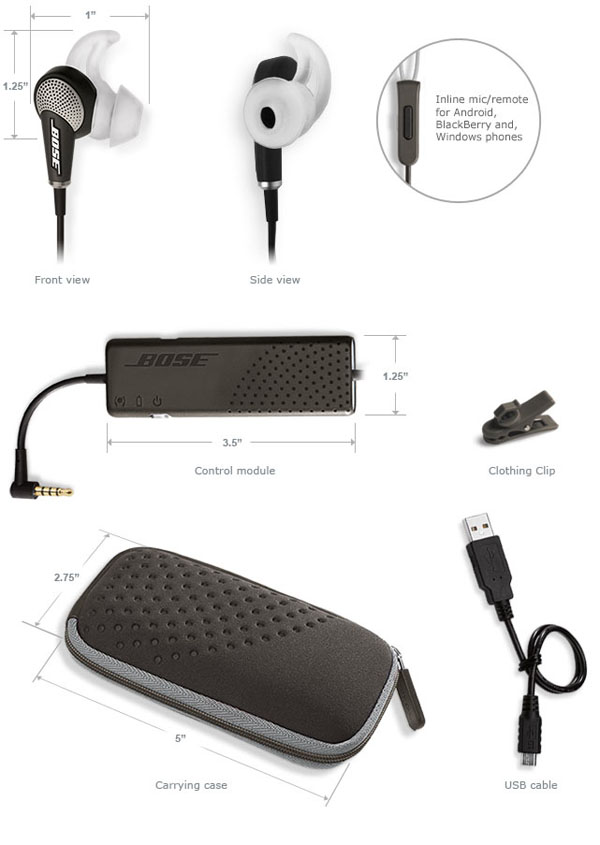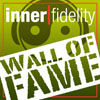| Columns Retired Columns & Blogs |
A Traveler's Sanctuary: The Bose Quiet Comfort 20 Noise Canceling Earphone Page 2

Isolation (noise canceling)
In a word: Stunning! You'll have to look at the measurements on the next page to see what I mean, but the odd thing about the Bose QuietComfort 20 is the evenness of the isolation. At about 25dB down across the board, the QC20 has the most even isolation of any headphone/earphone I've measured.
Again, I'll speculate a bit here: If you look into the nozzle of the QC20, you'll see a short metal cylinder just inside. I think this is one of the microphones used in the noise canceling circuit. It seems to me the advantage of this type of in-ear noise canceler with a mic right in the canal area is that you have a very short acoustic feedback path. This, it seems to me, allows for two things: a faster noise canceling circuit, which will allow for effective noise canceling at higher frequencies; and the ability to monitor and control bass response even with a somewhat leaky seal. We'll get to the bass response in the "Sound Quality" portion of this review in a moment.
The broadband noise canceling ability of the QC20 was immediately apparent to me. When vacuuming, I was very surprised to hear only a slight, high-pitched whine when the noise canceling was engaged. Air travel with the QC20 was a treat, on my last two flights the Bose noise canceler delivered a sense of having my own private listening sanctuary like no other headphone I've had.
Engaging the Aware mode on the remote opens a mic to the outside world and puts you back in communications with your surroundings. Noise canceling is significantly reduced, and outside sound is heard with good fidelity. The sound heard on the earphones from the music source remains unchanged with Aware Mode activated. You will likely need to reduce the music volume to hear outside sounds clearly; I think it would have been cool if the QC20 lowered the music volume automatically when the Aware Mode is activated.
I've seen a couple comments in QC20 threads mentioning some audible noise when turned on. I do hear a small amount of noise when the QC20 is turned on, but it's at a very low level, and in my relatively quiet home I hear a greater reduction in the background noise than the additional noise of the circuits. In other words, while the noise canceling circuit is adding a small amount of noise, turning it on reduces the noise I experience even in a fairly quiet environment. I do not consider the additional noise from the circuit operation as problematic in any substantive way.
Sound Quality (Noise Canceling Active)
I found the Bose QuietComfort 20 roughly on-par with the sound quality of the better in-ear monitors in the $100-$150 price range...which means, unbelievably good sounding for a noise canceler. Not only have I not heard a better noise canceling earphone, I've not heard one that even comes close to this good...and that includes Bose' own QuietComfort15.
The bass response is fairly tight and well extended, though there's a slight warm tilt measured, I would characterize the QC20 as a neutral earphone. The mid-range too is remarkably even, with a very slight emphasis on the upper-mids and presence region. Treble response is the weak point in these cans: I hear it as a bit grainy and "papery" sounding with the top octave somewhat withdrawn. The overall impression is that they're slightly veiled and rough sounding. So no, they don't have the extension and air of a really good IEM, but they deliver quite competent response without any glaring flaws, and that's lightyears ahead of the other noise cancelers I've heard.
I want to dwell on the low frequency response for a moment: While it doesn't have the last bit of tightness one might get on high-quality headphones, and while measurements show some low-frequency phase shift, I also hear and measure very good extension to 20Hz. I find this extraordinary given that the StayHear+ tips really don't provide a very good seal with the ear canal. I've spent a bit of time scrounging through Bose noise canceling patents—and there are a lot of them—for some hints on this subject. I didn't find much, but there are some hints that significant numbers of adaptive filtering and psychoacoustic trickery are being used in the low-frequency control of noise canceling headphones. At any rate, I think Bose did a great job of delivering satisfying bass response in these earphones.
Sound Quality (Passive Mode)
The QC20 can operate with the power off or a dead battery in passive mode. Sound quality in this mode is somewhat worse than with the electronics activated, but remains passable. Bass response is less well extended; mids are uneven, but don't sound terribly colored; and the treble seems duller and less responsive. None the less, I felt the passive response had no glaring problems and was a listenable alternative when the battery dies.
Summary
 The Bose QuietComfort 20 is simply the best noise canceler I've experienced. It's comfy, convenient, very effectively silences your surroundings, and sounds very good...stupendously good for a noise canceler.
The Bose QuietComfort 20 is simply the best noise canceler I've experienced. It's comfy, convenient, very effectively silences your surroundings, and sounds very good...stupendously good for a noise canceler.
A two hour charge will get you 16 hours of run time on the internal lithium-ion battery; which Bose claim will take 500 charge cycles before beginning to deteriorate. It's not replaceable, so your $299 investment will last you about 5 years. Given the outstanding performance of these earphones and my distaste for aluminum sky-tube travel, I'd say they're worth every penny.
The Bose QuietComfort 20 will be going up on the "Wall of Fame" as the best noise canceling headphone. I'd like to be proven wrong, but I suspect the QC20 will hold that honor for a long time to come.
Resources
Bose home page and QC20 product page.
Head-Fi threads here, here, and here.
- Log in or register to post comments




































